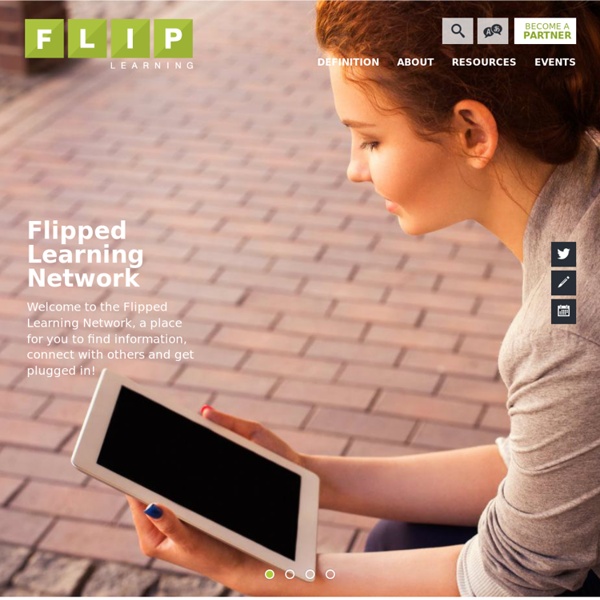



Flipped Classroom 2.0: Competency Learning With Videos The flipped classroom model generated a lot of excitement initially, but more recently some educators — even those who were initial advocates — have expressed disillusionment with the idea of assigning students to watch instructional videos at home and work on problem solving and practice in class. Biggest criticisms: watching videos of lectures wasn’t all that revolutionary, that it perpetuated bad teaching and raised questions about equal access to digital technology. Now flipped classroom may have reached equilibrium, neither loved nor hated, just another potential tool for teachers — if done well. “You never want to get stuck in a rut and keep doing the same thing over and over,” said Aaron Sams, a former high school chemistry teacher turned consultant who helped pioneer flipped classroom learning in an edWeb webinar. “There is no place for them to hide. The two teachers admit when they started flipping their classrooms they put everything into video form.
The Flipped Class: Myths vs. Reality Editor's Note: On the heels of our viral posts in over 100 countries about the flipped classroom earlier this year (links below), we asked Jon Bergmann if he could share some of the feedback he was receiving in light of the notable interest about this topic. The timing couldn't have been more perfect since he was about to leave for a conference about you-guessed-it, the flipped class. Here is Part 1 of our three part series The Daily Riff. See Part 2 and 3 links below. - C.J. The Flipped Class: What it is and What it is Not by Jon Bergmann, Jerry Overmyer and Brett Wilie There has been a lot of interest in the flipped classroom. The traditional definition of a flipped class is: The Flipped Classroom is NOT: A synonym for online videos. Originally published The Daily Riff July 2011 Jon Bergmann is one of the first teachers to flip his classroom and has recently co-authored a book on the the Flipped Class which is to be published by ISTE press. Video Montage from Conference Below
The Teacher's Guide To Flipped Classrooms Since Jonathan Bergman and Aaron Sams first experimented with the idea in their Colorado classrooms in 2004, flipped learning has exploded onto the larger educational scene. It’s been one of the hottest topics in education for several years running and doesn’t seem to be losing steam. Basically, it all started when Bergman and Sams first came across a technology that makes it easy to record videos. They had a lot of students that regularly missed class and saw an opportunity to make sure that missing class didn’t mean missing out on the lessons. And voila: a movement began. A 2014 survey from the Flipped Learning network found that 78% of teachers said they’d flipped a lesson, and 96% of those that tried it said they’d recommend it. What is a flipped classroom? Once a new idea becomes a buzzword, pinning down the definition can become a tad more challenging. That gets the idea across, but it’s a bit of a mouthful. The Benefits of Flipping Your Classroom 1. 2. 3. The Backwards Classroom 1.
9 Video Tips for a Better Flipped Classroom -- THE Journal Flipped Classroom | November 2013 Digital Edition 9 Video Tips for a Better Flipped Classroom Early adopters share how schools can find success with teachers and students alike--even when the technology seems as topsy-turvy as the lessons. In 2007, when Colorado high school teachers Jonathan Bergmann and Aaron Sams began experimenting with recording their lectures in order to spend class time on deeper face-to-face learning with students, they probably didn't foresee the major movement that would grow up around what came to be called the flipped classroom. But six years later, the growth in interest remains exponential, suggesting this is far more than a fad. Today, it seems, there is no one correct way to flip the classroom, and approaches vary both by subject and educational philosophy. 1) Devise a flipped strategy. • Will teachers make their own videos, curate others' material, or a combination of the two? • What video-creation software should teachers use?
Modifying the Flipped Classroom: The "In-Class" Version So. You've tried flipping your class, and it didn't go well. Or you've heard about flipping and want to try the approach, but you're pretty sure it won't work in your school. Don't give up yet -- with a slight twist, flipping might be possible for you after all. Flipped classrooms -- where direct instruction happens via video at home, and "homework" takes place in class -- are all the rage right now, and for good reason. But successful flipping has one big catch -- if it's going to work, the at-home learning absolutely must happen. Arranging access before and after schoolLending out devicesSending recorded lectures home on flash drives or DVDs These are all workable solutions. Modifying the Flipped Classroom Concept None of these problems should stop us from trying, but there's another way to apply the flipped model without the problems associated with sending the work home. The teacher records a lecture. An In-Class Flip works like this. This video shows you how to do it: Advantages
Video on Demand - Literary Visions - A Frame for Meaning: Theme in Drama Due to licensing agreements, online viewing of the videos for this resource is restricted to network connections in the United States and Canada. 1. First Sight: An Introduction to Literature This overview introduces the course content and approach. 2. Ways of Seeing: Responding to Literature A focus on critical approaches to literature is presented by the scholars who will appear throughout the series. This program also previews selected dramatic scenes from upcoming programs and excerpts from the author interviews that highlight the series. 3. 4. 5. 6. 7. 8. 9. 10. 11. 12. 13. 14. 15. 16. 17. 18. 19. 20. 21. 22. 23. 24.